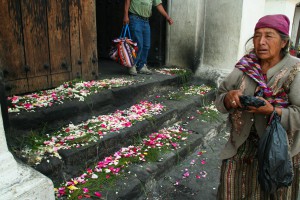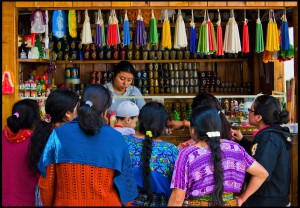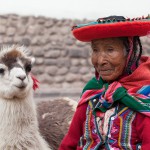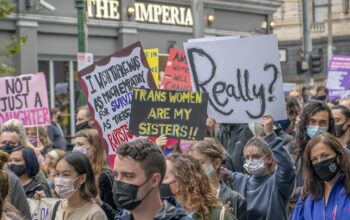September 14th, 2013 – Lago Atitlan, Guatemala
Today is an important day. Guatemala has been independent for exactly 192 years. I just arrived two days ago in this small village along the magnificent Lago Atitlan. My host mom told me I should go to Puerto San Jose, which is on the pacific coast, with some people from the village to celebrate the Independence. As I am freezing on the bus on the way, I ask myself: what am I really doing over here? This culture is so different from mine but you know what, I love it, I feel at home.
I was a swimmer for many years back in Canada and I always get really excited when it comes to the ocean. As soon as we arrive, I run towards the water like a kid. I am full of enthusiasm.
Suddenly something catches my attention. A lot of people are all looking and pointing at something. My curiosity overrides my excitement to go in the water. As I approach the crowd I see something lying in the sand, something with red on it… Now I am enough close to realise that it is a body, a dead body maybe? I don’t know, nobody is around, why are people not helping the man? His eyes are open, his face is covered with blood and totally destroyed. Why are people not helping him, doing CPR?  I walk as fast as I can towards the man. I cross that imaginary line that the other people aren’t crossing but I am not even half way when someone carries me back outside the circle. I try to fight back but the man is really strong. It all happens so fast, but I remember his face. He was mad, so mad at me. Why? I just wanted to help that man, maybe he was still alive? I saw him, I saw his eyes, I saw his body completely not okay. His curly black hair covered with sand and blood.
I walk as fast as I can towards the man. I cross that imaginary line that the other people aren’t crossing but I am not even half way when someone carries me back outside the circle. I try to fight back but the man is really strong. It all happens so fast, but I remember his face. He was mad, so mad at me. Why? I just wanted to help that man, maybe he was still alive? I saw him, I saw his eyes, I saw his body completely not okay. His curly black hair covered with sand and blood.
The man finally explains to me that if I touch the body, I will be the one considered responsible for his death. It is 7:30 in the morning but the body was in the same spot when the man arrived at 6A.M. The police didn’t show until 9A.M to cover up the body.
For an entire week I could not sleep. My host family was laughing at me. Every time we would see a dead body on TV they would cover my eyes and tell me “don’t look Aurora, you will have nightmares again”. I was traumatised. I never saw a dead body like that before. Yes, when I closed my eyes I would still see his face, his eyes wide open. For a few days, I didn’t feel at home at all. This is not my world; I don’t want to live with such images.
I am a privileged white young adult, born and raised in a country where such images are not part of my everyday life. I have seen dead people, at the funeral home. I have seen dead people, on television and in the newspaper. Why was my host family not more shaken? Why was my heart beating fast just by reliving the memories, whilst others see more and more of that kind of violence and don’t question it?
I realised that even in a world where we talk about globalisation and the sharing of cultures, there are concepts that remain culture-specific. Death is one of them.
Guatemalans are in a phase where the consequences of 36 years of war are still visible. Violence perpetrated in the country is televised, without any shyness. They show bloody scenes with dead bodies uncovered. Some barrier about these kinds of horrors must have formed in the mind of Guatemalans. It doesn’t seem to be abnormal to look at those images, especially after so many years of violence. Canada, which is a much quieter country in terms of crime and homicides doesn’t have that kind of past. In 2012, Guatemala had 40 intentional homicides per 100 000 habitants while Canada had 2.
Concerning the fear of what happens after death, there may be a major difference between the two countries. In Guatemala, the majority of the population is still involved in religion; Catholics make up 50-60% of the population while Protestants account for 35-40%. Only 1% are still considered followers of the Indigenous Mayan faith. In Canada, Catholicism is the dominant religion with 43.6% out of a population which is 67% Christian. More than 24% of Canadians consider themselves atheist.
This has implications on the perception of what happens after death. Religion promotes continuity after death. In addition, 95% of the Guatemalan population is considered indigenous. Maya is the culture that they identify themselves as belonging to. For the Mayans, there are strong beliefs about the reincarnation of the dead in the living world.  Having such beliefs affects how we approach death. Moreover, lots of ceremonies are still performed today, especially in rural regions. The Kame is the day of celebrating and asking the dead people for strength, as they are believed to be guides that accompany individuals during their earth lives. The objective of this tradition is to avoid all kinds of dangers, diseases and pains and to seek protection while traveling. During the celebration, there is a communication that is created between the superior beings and access is granted to the dimensional gates.
Having such beliefs affects how we approach death. Moreover, lots of ceremonies are still performed today, especially in rural regions. The Kame is the day of celebrating and asking the dead people for strength, as they are believed to be guides that accompany individuals during their earth lives. The objective of this tradition is to avoid all kinds of dangers, diseases and pains and to seek protection while traveling. During the celebration, there is a communication that is created between the superior beings and access is granted to the dimensional gates.
It’s been a year since I came back from Guatemala but I am still shocked by all the dead bodies I saw. The perception of death differs from one culture to another based on history, religion, rituals and many other factors. Each individual is also different and so is the way they perceive death. A painter from the village I was staying in said, “I’m Catholic and I strongly believe in life after death. I never saw a corpse in real life and I wouldn’t want to. Death is the end of this life but the beginning of another one “.
I fell in love with Guatemala and its people and I can’t wait to go back. I know I have to be careful with my reactions and the way I perceive the differences because they all have a history behind them. The last thing I would want is a conflict due to misunderstandings.
By Aurore Menard
Image credit:
Picture 1: Alex Schwab, licensed under CC BY-ND 2.0
Picture 2: Guillén Pérez, licensed under CC BY-ND 2.0








